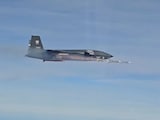It seems the dust has settled over a limited war between India and Pakistan, even as Pakistan is getting ready to take full advantage of US President Donald Trump's statements by calling for "comprehensive" dialogue on Kashmir. The Ministry of External Affairs has categorically said that no such dialogue would take place, unless it was on terrorism or Pakistan-Occupied Kashmir. That's that, though these are all opening shots.
Meanwhile, there is a worrying development that few have taken note of. The so-called Al Qaeda in the Indian subcontinent (AQIS) declared in English and Urdu that all Muslims were obliged to launch a 'holy war' against the 'Bhagwa' regime in India for targeting mosques and 'settlements' in Pakistan. That's worrying. After all, the group, after virtually disappearing from the terrorist scene, now seems to have decided to make a comeback, entirely in support of Pakistan.
The AQIS Revives Again
Al Qaeda in the Indian subcontinent (AQIS) is a curious group. It was formed in 2014, apparently on the command of the then Al Qaeda leader Ayman Al Zawahiri, and was led by Asim Umar. Its clear objectives were to hit American and Pakistani forces. However, after Umar was killed in a joint operation with the US in 2019, the group turned mysteriously against India, and away from Pakistan. It even launched a new magazine, the Nawa- Ghazwatul - Hind (Voice of the Battle for India).
That was puzzling. Nothing much was heard about the group or its activities, until the National Investigation Agency (NIA) arrested some 53 people from Assam - some of them Bangladeshis - in 2022. A whole network was unearthed, including madrassas and several teachers, apart from specific modules, all of which pointed to a long-term plan to raise insurrection in the east of India. This was linked to the Ansarullah Bangla group in Bangladesh.
In July 2024, the UN Sanctions Committee report observed close proximity between the Tehrik-e-Taliban Pakistan (TTP) and the AQIS, sharing camps and training, and carrying out attacks under the name of Tehreek-e-Jihad Pakistan. It also added that the Taliban was another supporting body.
Now consider how UN reports after the Pahalgam attack last month have completely dropped any reference to the Lashkar-e-Taiba (LeT) and the Jaish-e-Mohammad (JeM), and refused to make any reference to the Terrorist Resistance Front (TRF), all due to Pakistani pressure, as India's Foreign Secretary, Vikram Misri, said in his presser. So, it seems that UN reports are not entirely to be relied upon, given that it is made up of inputs from member states, which includes Pakistan.
Pakistan has its script ready about the imminent threat from TTP. But here's also the reality: the TTP is made up of some 40 groups, and though most are indeed targeting Pakistan, there are groups that have been co-opted by the agencies, particularly opposite the Kurram Agency. It has also long had links with sections of the Islamic State. This is the classic Pakistani method of influencing operations. This manipulation of designated terrorist groups and their allies has been going on for years.
The Unholy Alliance
That an unholy alliance exists between Pakistan's intelligence agencies and various jihadi groups in Afghanistan is a reality. Consider the torture and killing of Saleem Shehzad, a courageous journalist who exposed links between 'rogue' army officers, including Illyas Kashmiri, and Al Qaeda. That last aspect has since come out vividly in the interrogation of David Headley, who dealt with both serving and retired Pakistani army officers during the planning for the 26/11 attacks in Mumbai in 2008. There's more: an honourable Pakistani officer, Major General Faisal Alavi, was shot dead in broad daylight in Islamabad in the same year months after he had sent a letter with names of officers tied to Al Qaeda to the then army chief, General Ashfaq Parvez Kayani, and even exposed a deal with Baitullah Mehsud, a militant who was dreaded by the Pakistani forces. Wheels within wheels.
To bring all these threads together, it is necessary to note Pakistani objectives. One is to force India to come to the negotiating table, something it has already begun to act on. The second is to a deep Hindu-Muslim divide, which was more than apparent in Asim Munir's speech and in the terrorist attack at Pahalgam. A third goal is apparent in the various Track-2 events in which the Pakistanis try their best to get the US back into Pakistan, even going to the extent of warning of another 9/11-like attack. That ensures some balance against China, which has been pushing the Pakistanis hard by way of intrusion into intelligence circles and physical presence of troops, and, importantly, with that a lot of money in terms of 'reimbursements' during counter-terror operations, along with, much more importantly, a diplomatic heave-up in international circles.
What India Must Be Careful About
There is much that is possible if Pakistan decides to use the AQIS either against US assets in Afghanistan or against them in India - the latter being a far more attractive option to it. In addition, given the group's established presence in Assam, the AQIS statement comes at a time when Pakistani intelligence is deep within Bangladesh. Any massive attack by it would technically be completely denied by Pakistan, but it could goad the Indian army into further eroding its relationship with Dhaka.
There are multiple motives here, and much that India needs to do. The first thing is to take the US agencies and others into a consultation mode, where available intelligence is shared to estimate the group's potential capabilities. Trump may ignore the terrorist history of the Pakistan army, but US intel circles are well aware of it. It's time to take an intel huddle. However, the focus of our intel thrust should be on improving the monitoring within the country, using the best technology available - facial recognition, big data, AI, et al - especially in sensitive areas.
The aim is to tear India apart from within, and the call has already gone out.
(Tara Kartha was with the National Security Council Secretariat)
Disclaimer: These are the personal opinions of the author















